There are several ways to react to being lost. One is to panic: this was usually Valentina's first impulse. Another is to abandon yourself to lostness, to allow the fact that you've misplaced yourself to change the way you experience the world. - Audrey Niffenegger
4 September 2019, Yaoundé to Chinese camp, 67.93km
Chinese road construction camp 0CFA (R0)
Having decided to take the old road to Douala (Ancienne Route de Douala) for the first 60km west of Yaoundé until it joins the N3, we plotted a route out of the city. At the bottom of our road, turn left; at the end of the road, turn right; then first left and first right passing the Niger consulate and edging right. At the end of the road take a right onto route 1750 (many roads in Yaoundé are named by four-digit numbers). At the next large carrefour (intersection), drift left, and turn left again at the next major intersection. Second right into 2716, and beyond Yoyo Yaoundé, hook left into 6251. After a zig and a zag, turn right at Carrefour Meec onto the old Douala road. Roads are seldom clearly marked, so we stopped now and then to check Google Maps, but made it without let or hindrance onto the our chosen road out of town.
We did not know this would soon turn to rough (with dirt to follow), and certainly had no idea that shortly thereafter an indispensable whatsit on Charl’s derailleur would crack in two, tangling his chain in his gear cogs and making it impossible to cycle further. Luckily we were carrying a spare whatsit, which Charl replaced, having untangled the chain, but then a real problem... Charl, not thinking clearly in a moment of frustration, cut a frayed cable, leaving insufficient length for it to do its job of changing gears. We had a spare cable section, but no way to splice the new to the old.
There being no bike shops in Yaoundé, decision time… Should we separate with Charl getting a lift to Douala and me cycling the four or five days alone? Or should we call it quits and both take a bus? Separating would (a) substantially increase our budgetary requirements as we would both require accommodation which costs as much for one as for two; and (b) we would have to repack all the bags so I would have the tools and camping equipment in case I had a puncture and there was no accommodation en route. Reluctantly we settled on the bus and began to retrace our steps when we were haled by a young man from an autocycle “garage” who, seeing we were in trouble, proposed trying to resolve our problem. Which he miraculously did, simply tying the two cables together to create sufficient length. We have no idea whether this gerrymandered solution will get us to Douala, but it certainly put us back on the road, though rather late in the day.
Progress was slow on our rough road, retarded further by a lengthy gendarme stop where our passport details were painstakingly entered in a log book and a phone call placed to the chef (chief). It is not surprising, therefore, that at an intersection sporting a large and faded sign saying “Welcome to the Yaoundé-Douala Highway 1000m” we were lured off our road. What we found was a work-in-progress, a double-carriage highway-to-be, just 40km completed and little used. Following a discussion with an English-speaking guard, we opted to take the highway and felt pretty chuffed speeding along new tar, until it ended abruptly…
We had understood from the guard that Matomb village and its auberge (guest house) lay where the tar ended, when it fact it lay some distance away along a dirt track. It looked like rain and was too late in the day to attempt to reach Matomb, so we turned back toward a road construction camp we had seen off the highway, hoping to persuade the workers there to offer us a place out of the rain to erect our tent. It was a longer climb up steep dirt than we had thought, but in the end we found welcome shelter.
Many of the workers at the camp spoke English, Mr Kelvin taking us under his wing. One Chinese engineer who speaks neither English nor French is in charge of the highway project, employing locals, many of whom live at the camp, some with wives and children. The rooms are constructed of corrugated tin and wood. A generator provides electricity until 21:30, when the camp is plunged into darkness and relative quiet. Water is delivered to the camp and stored for bucket baths and loo flushing. The loos follow a similar design to one we once saw in China, though the Chinese version was constructed of stainless steel, this one of cement. One channel is dug and cemented and runs through several cubicles. You squat astride the channel, your back to the longer length of the cubicle. Anything deposited in the channel, flows through subsequent cubicles and out a communal hole. Mr Kelvin provided us each with a bucket of water. You bathe over the channel too, flushing it with bath water.
Mr Kelvin is an Anglophone Cameroonian from Bamende, north of Bafoussam, one of the current hotspots in the Anglo-Francophone conflict. His home and business, a dress shop, were burned to the ground by, I think, government troops. He has been working on the highway for three years, making gravel, a noisy business. “Hiding out”, he said. He is bright and a student of history. He approved initially of the federal solution to combining the two Cameroons, but now believes the only solution is separation.
We were allowed to erect our tent in a small wood structure with built in tables and benches where there was just enough room to accommodate its length. We had people popping in to chat during the course of the evening, and to watch us cook our dinner, and a slightly larger audience, fascinated by our tent and blow up mattresses and other equipment. Particularly that we could carry all of it on the bikes. A good evening with kind people.
For today's route see below photos
For overview route, click on ROUTE tab above…
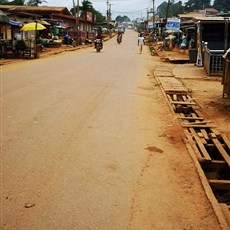
Leaving Yaoundé
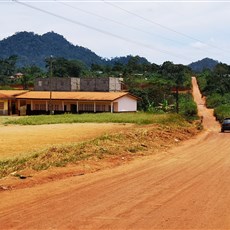
Yaoundé to Chinese camp
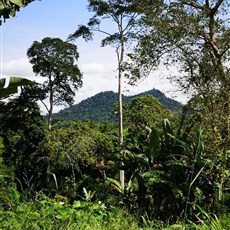
Yaoundé to Chinese camp
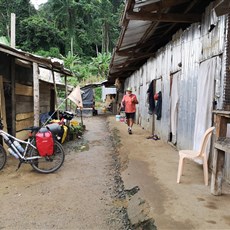
Chinese camp
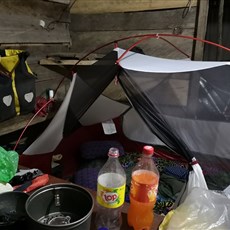
Chinese camp

Chinese camp